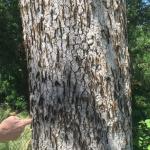Green spanworm moths are out flying. Do not target this stage of the life cycle for control. Cranberry fruitworm moths are also out, scouting for just the right berry. Now is the time to be planning your CFW management approach as 50% out-of-bloom won’t be that far away. Gypsy moth larvae are dying on the trees. They have been infected with the fungus and their bodies will be dissolving and decaying. No need to be spending time or money to control these. See photo of larvae on tree trunk near the station.
Herbicides containing clethodim cannot be applied between hook and fruit set. A Valent technical representative explained that this restriction is included because fused flowers were observed during product testing. During our recent testing at the Cranberry Station, we observed fused flowers after some clethodim applications made during rough neck, BEFORE any flowers were present. Flower fusing might be caused by internal changes in the cranberry plant, rather than flower petals getting physically “glued” together by the product. Despite the abnormal looking flowers, the bees were able to pollinate successfully and yield did not appear to be affected but we are still evaluating.
Poast is another grass herbicide with a related, but different, active ingredient (sethoxydim). There is no label restriction on applying Poast during hook to fruit set. It is recommended that Poast be used with crop oil, and grass control is more effective when it is included. The label states that using Poast with adjuvants at temperature above 90° F (or anytime the temperature exceeds 100° F regardless of the humidity) and relative humidity at or above 60% may result in injury. Flower petal fusing has not been observed with Poast use.
